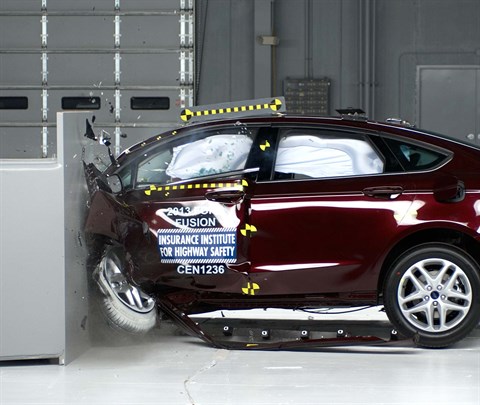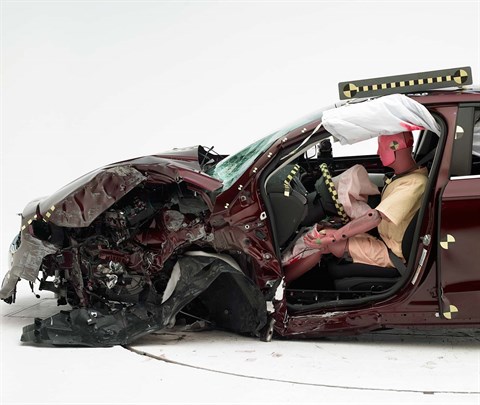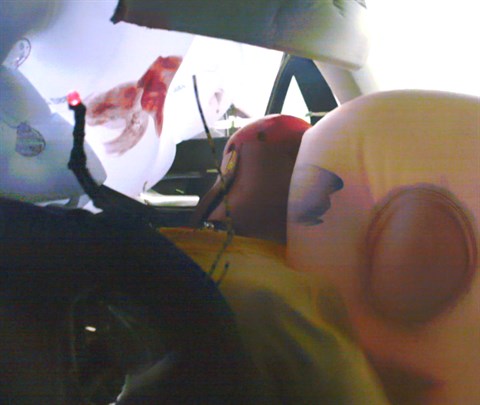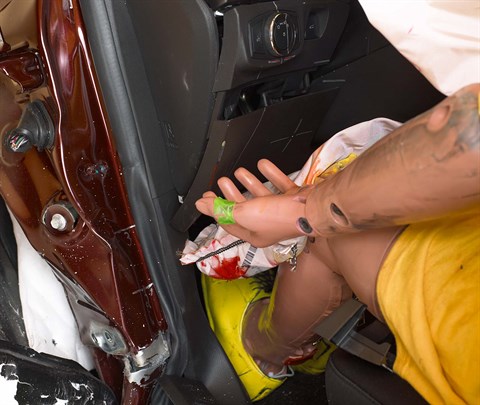Small overlap front: driver-side
Rating applies to 2013-16 models built after December 2012
Tested vehicle: 2013 Ford Fusion SE 4-door
The Ford Fusion and Lincoln MKZ were redesigned for the 2013 model year. Beginning with 2013 Fusion models built after early December 2012, structural changes were made to improve occupant protection in small overlap frontal crashes. (Information about when a specific vehicle was manufactured is on the certification label typically affixed to the car on the driver door or adjacent B-pillar.) The tested Fusion and all 2013 MKZ models were built after the structural changes were in place.
| Evaluation criteria | Rating |
|---|---|
| Structure and safety cage | |
| Driver injury measures | |
| Head/neck | |
| Chest | |
| Hip/thigh | |
| Lower leg/foot | |
|
Driver restraints and dummy kinematics
The dummy’s head barely contacted the frontal airbag before sliding off the left side and leaving the head vulnerable to contact with forward structure. The side curtain airbag deployed and had sufficient forward coverage to protect the head from contact with side structure and outside objects. | |

Action shot taken during the small overlap frontal crash test.

The dummy's position in relation to the door frame, steering wheel, and instrument panel after the crash test indicates that the driver's survival space was maintained reasonably well.

The dummy’s head contacted the frontal airbag but then slid off the left side. The side curtain airbag extended far enough forward toward the A-pillar to protect the head from contact with forward side structure.

Except for door hinge pillar deformation, intrusion into the driver's space was reasonably well controlled, and risk of injuries to the dummy's legs and feet was low.
Moderate overlap front: original test
Rating applies to 2013-16 models
Tested vehicle: 2013 Ford Fusion SEL 4-door
The Ford Fusion and Lincoln MKZ were redesigned for the 2013 model year. Moderate overlap frontal ratings are assigned by the Institute based on a test of a Fusion conducted by Ford.
| Evaluation criteria | Rating |
|---|---|
| Overall evaluation | |
| Structure and safety cage | |
| Driver injury measures | |
| Head/neck | |
| Chest | |
| Leg/foot, left | |
| Leg/foot, right | |
| Driver restraints and dummy kinematics | |
Side: original test
Rating applies to 2013-16 models
Tested vehicle: 2013 Ford Fusion SEL 4-door with standard front and rear head curtain airbags and standard front seat-mounted torso airbags
The Ford Fusion and Lincoln MKZ were redesigned for the 2013 model year. Side ratings are assigned by the Institute based on a test of a Fusion conducted by Ford.
| Evaluation criteria | Rating |
|---|---|
| Overall evaluation | |
| Structure and safety cage | |
| Driver injury measures | |
| Head/neck | |
| Torso | |
| Pelvis/leg | |
| Driver head protection | |
| Rear passenger injury measures | |
| Head/neck | |
| Torso | |
| Pelvis/leg | |
| Rear passenger head protection | |
Roof strength
Rating applies to 2013-20 models
Tested vehicle: 2013 Ford Fusion SE 4-door
| Overall evaluation | |
|---|---|
| Curb weight | 3,411 lbs |
| Peak force | 17,527 lbs |
| Strength-to-weight ratio | 5.14 |
Head restraints & seats
Seat type: Power cloth seat
| Overall evaluation | |
|---|---|
| Dynamic rating | |
| Seat/head restraint geometry |
About the head restraint & seat test
Currently, IIHS tests apply only to front seats.
Front crash prevention: vehicle-to-vehicle
Child seat anchors
Rating applies to 2015-16 models
| Evaluation criteria | Rating |
|---|---|
| Overall evaluation | |
| Vehicle trim | SE |
| Seat type | cloth |
This vehicle has 2 rear seating positions with complete child seat attachment (LATCH) hardware.
It has 1 additional seating position with a tether anchor and the ability to borrow lower anchors from the other seating positions.
Note: When anchors are borrowed, they aren't available to use in their designated positions.
| Evaluation criteria | Rating |
|---|---|
| Overall evaluation | |
| Vehicle trim | SE |
| Seat type | cloth |
| Rating icon | Rating |
|---|---|
| G | Good |
| A | Acceptable |
| M | Marginal |
| P | Poor |
| Seating positions that rely on borrowed lower anchors or have only a tether anchor available are not rated. | |
thether anchor symbol | Tether anchor |
lower anchor symbol | Lower anchors |
| Lower anchor(s) can be borrowed from adjacent positions(s) | |
| No hardware available |
Details by seating position
| Position | Rating |
|---|---|
| 1 | |
| Tether anchor | |
| easy-to-find location | |
| no other hardware could be confused for anchor | |
| Lower anchors | |
| too deep in seat | |
| not too much force needed to attach | |
| difficult to maneuver around anchors | |
| 2 | |
| Tether anchor | |
| easy-to-find location | |
| no other hardware could be confused for anchor | |
| Lower anchors | |
| Can be borrowed from 1 and 3 | |
| 3 | |
| Tether anchor | |
| easy-to-find location | |
| no other hardware could be confused for anchor | |
| Lower anchors | |
| too deep in seat | |
| not too much force needed to attach | |
| difficult to maneuver around anchors |
